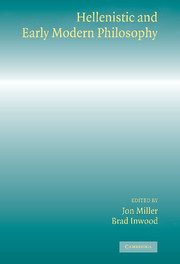Book contents
- Frontmatter
- Contents
- List of Abbreviations
- Notes on Contributors
- Preface
- Introduction
- 1 Stoicism in the Philosophical Tradition
- 2 Early Modern Uses of Hellenistic Philosophy
- 3 Locke's Offices
- 4 Patience sans Espérance: Leibniz's Critique of Stoicism
- 5 Epicureanism in Early Modern Philosophy
- 6 Stoics, Grotius, and Spinoza on Moral Deliberation
- 7 The Discourse on the Method and the Tradition of Intellectual Autobiography
- 8 Subjectivity, Ancient and Modern
- 9 Spinoza and Philo
- 10 Hume's Scepticism and Ancient Scepticisms
- 11 Stoic Naturalism in Butler
- Bibliography of Primary Sources
- Bibliography of Secondary Sources
- Index (general)
- Index (of selected text passages)
1 - Stoicism in the Philosophical Tradition
Spinoza, Lipsius, Butler
Published online by Cambridge University Press: 05 August 2012
- Frontmatter
- Contents
- List of Abbreviations
- Notes on Contributors
- Preface
- Introduction
- 1 Stoicism in the Philosophical Tradition
- 2 Early Modern Uses of Hellenistic Philosophy
- 3 Locke's Offices
- 4 Patience sans Espérance: Leibniz's Critique of Stoicism
- 5 Epicureanism in Early Modern Philosophy
- 6 Stoics, Grotius, and Spinoza on Moral Deliberation
- 7 The Discourse on the Method and the Tradition of Intellectual Autobiography
- 8 Subjectivity, Ancient and Modern
- 9 Spinoza and Philo
- 10 Hume's Scepticism and Ancient Scepticisms
- 11 Stoic Naturalism in Butler
- Bibliography of Primary Sources
- Bibliography of Secondary Sources
- Index (general)
- Index (of selected text passages)
Summary
Diffusion and Diminution
Of all the ancient philosophies, Stoicism has probably had the most diffused but also the least explicit and adequately acknowledged influence on Western thought. No secular books were more widely read during the Renaissance than Cicero's On duties (De officiis), the Letters and Dialogues of Seneca, and the Manual of Epictetus. Thomas More's Utopians define virtue as “life in accordance with nature,” and this is characteristic of the way slogans and concepts of Stoic ethics were eclectically appropriated from about 1500 to 1750. Neo-Stoicism (capitalized) is a term often used to refer to currents of thought in the seventeenth and eighteenth centuries, and it is quite appropriate to such figures as Lipsius and du Vair. Yet in spite of the Stoic traces in Descartes, Spinoza, Leibniz, Rousseau, Grotius, Shaftesbury, Adam Smith, and Kant (traces that modern scholars are increasingly detecting), Neo-Stoicism scarcely had an identifiable life comparable to Medieval Aristotelianism, Renaissance and later Scepticism, seventeenth-century Epicureanism, or Renaissance Platonism and the Cambridge Platonists. It was not determinate enough to mark a whole period or intellectual movement.
In recent decades, ancient Stoicism has become a mainstream scholarly interest. Not coincidentally, this revival is echoed in work by such well-known thinkers as Foucault, MacIntyre, and Taylor, and we now have Becker's intriguing book, A New Stoicism, which offers itself as the kind of ethical theory that a modern Stoic could and should defend. But Stoicism as systematic philosophy has hardly been refashioned at any time.
- Type
- Chapter
- Information
- Hellenistic and Early Modern Philosophy , pp. 7 - 29Publisher: Cambridge University PressPrint publication year: 2003
- 4
- Cited by



